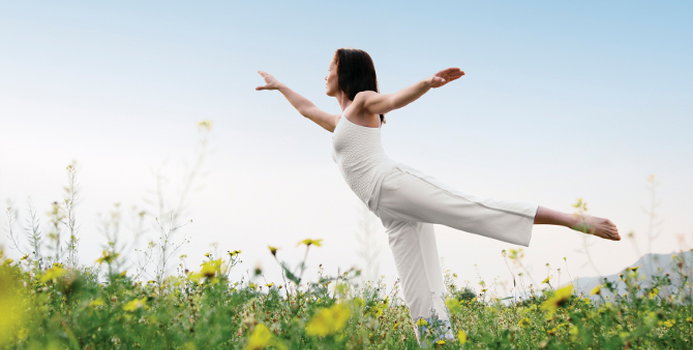Trainers, instructors and anyone else with an involvement in yoga will want to understand Iyengar yoga and what it brings to the fitness community. As a more modern type of yoga practice, Iyengar yoga offers some specific benefits in bringing the principles of traditional yoga styles to a modern Western audience.
Origins of Iyengar YogaIyengar yoga is generally attributed to the work of Bellur Krishnamachar Sundararaja Iyengar, or B.K.S. Iyengar, an individual who taught his own style of yoga throughout the 20th century and was featured in major news outlets. The Iyengar yoga discipline is based on much older forms of yoga, primarily on the centuries-old Hatha yoga style that some call "dual" or "yoking" yoga, as it deals with the use of polar opposite paradigms. Iyengar yoga keeps some of the main principles of Hatha yoga, such as the "eight limbed" concept that is central to bringing together all of the "asanas" or postures of yoga.
What Are Yoga Asanas?They are often translated as "postures," but asanas, to many of those who practice yoga, are more than just body positions. A deep reading of yoga traditions shows that asanas are often physical manifestations of profound spiritual concepts. Some see the asanas as practical tools for attaining specific mind-body connections that are mentioned in traditional yoga references.
Purpose of Iyengar YogaThe main thing that Iyengar yoga adds to the equation has to do with the asanas or postures mentioned above. Some of these postures or body positions can be very challenging for beginners. Iyengar yoga became renowned for adding specific "yoga props" to yoga sessions. These tools, including forms of resistance bands or straps, help those less able to attain correct postures for specific yoga practice.
In addition to using specific fitness tools, Iyengar also promotes active trainer correction in helping participants find the precise asanas or postures intended to elevate the mind and body. With more active correction than some other types of yoga, Iyengar is likely to help a wider range of students to profit from some of the time tested values of yoga positioning. That's part of why medical professionals look at Iyengar yoga in particular for treating a range of conditions, from mental conditions like depression, to backaches, arthritis and more.
Some Pros and Cons of Iyengar YogaAs mentioned above, Iyengar yoga can be one of the best styles for helping inexperienced students with challenging positioning. The downside, to some trainers, would be that this kind of diversified activity can get in the way of some of the meditative aspects of yoga. Another issue is that with the greater set of tools used in Iyengar yoga, including straps as well as foam blocks and other bulkier items, this kind of yoga can be less portable than the traditional styles that are done with only a simple personal yoga mat.
Each individual has her own specific needs for beginning a yoga program. Iyengar yoga might be added to a personal program according to the student's level of capability, or it might be part of a group session for helping more members of an audience to quickly master some of the basics, or more advanced poses and postures.
Look for elements of Iyengar yoga in the public resources available all over the world, in training manuals and instructed classes, and evaluate whether a more guided yoga program is right for your needs.



